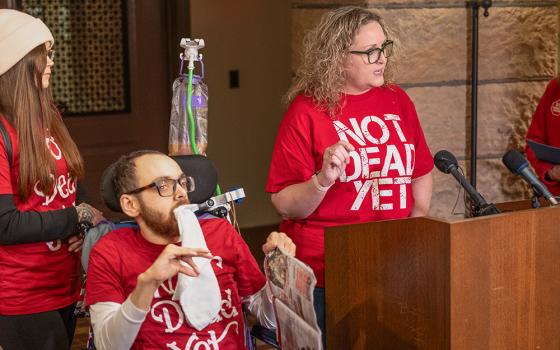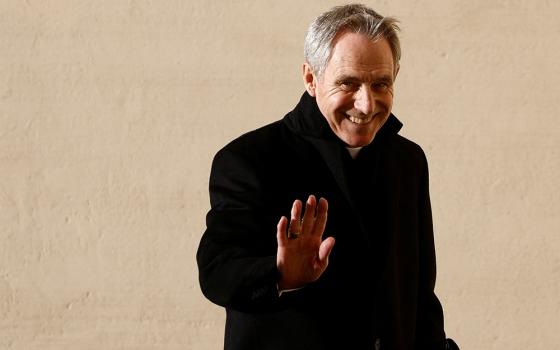Yesterday, I looked at this week’s USCCB meeting through the lens of four interventions in the discussion on Faithful Citizenship, interventions that highlighted some of the divisions within the conference about the role of the Church in society. Today, I would like to look at two other aspects of the meeting which are more ecclesial in nature.
During the recent synod, many synod fathers talked about how the changed format -- emphasizing fewer floor speeches and more small group discussions, and interspersing the small group meetings throughout the three weeks, rather than saving them to the end -- made for a much more synodal process. The bishops actually wrestled with ideas and forged consensus, nothing was off-limits in the discussion, and the entire event was more akin to a genuine synodal process than previous iterations of the synods in the Latin Church.
In addition, Pope Francis delivered a major address during the synod on the occasion of the 50th anniversary of the restoration of Western synods at the conclusion of the Second Vatican Council. "The journey of synodality is the journey that God wants from his church in the third millennium," the Holy Father said in his Oct. 17 address. "A synodal church is a listening church, aware that listening is more than hearing. It is a reciprocal listening in which each one has something to learn." He called for this synodal approach to inform all levels of the church.
The USCCB has long been an exercise in collegiality, even before the concept of collegiality was dusted off at Vatican II. The provincial councils of Baltimore in the first half of the nineteenth century and the plenary councils in the second half, the annual meetings of the nation’s archbishops, and in 1919, the formation of the National Catholic Welfare Conference, forerunner of today’s USCCB, all exemplified collegiality. But, the USCCB in the twentieth century did not become an exercise in synodality. The model was more bureaucratic than synodal.
Bureaucracy and bureaucrats have gotten a bad name, much of it unfairly. Complex societies require expertise and a division of labor, which are the strengths bureaucracy supplies. And, most bureaucracies, governmental and ecclesial, do a very good job. I actually have had nothing but good experiences with the IRS and the DMV! But, bureaucracies invite turf wars, people learn quickly where the power is to make things happen or to block things from happening, incompetence can thrive, and multiple, conflicting agendas can rub up against each other without ever resolving some of the latent tensions beneath the surface. It is almost a given in Washington that the Pentagon and Foggy Bottom will be engaged in near constant struggles for the heart of the White House.
Synodality is different. It requires a "walking together," listening to one another, and mutual discernment, not floor reports that involve little discussion and debate. Meetings of CELAM, the supranational episcopal conference in Latin America, not only begin with ample consultation years in advance, but the meetings begin with the bishops gathering for days of prayer together, before they turn to their work. CELAM only meets once a decade or so, not annually, but I think the USCCB needs to find ways to integrate greater synodality into its current bureaucratic approach, drawing on the strengths of both models. It was clear listening to the bishops who attended the synod that they had different reactions to the experience. This change from a bureaucratic and monarchical model to a synodal model will not be easy, and the Church will always find its unity with and under Peter and will always have need of the expertise a bureaucracy affords, but the bishops need to take steps in the direction of synodality. It might produce a healthier kind of discussion and more fruitful meetings.
The other thing that stood out about this meeting is how very far removed much of the bishops’ conference agenda is from the lives of the Catholic faithful. Certainly, at a time when some politicians are turning immigrants into the whipping boys for their campaigns, and a time when 61% of Catholics under the age of eighteen are Latino, it was shocking that the bishops did not spend more time discussing what they can be doing, at all levels of Church life, to protect and defend immigrants. They are our people. They are our future. Instead, the bishops were debating the advisability of a new, lighter sacramentary for use at the chair, so that altar servers do not have to lug around the current big book. And, they were debating a statement on pornography, which is a problem, I understand, but is it really such a pressing problem? (I am not going to google “Latino porn” to see if it is a problem in the Latino community!) A fair amount of time has been spent fretting about same-sex marriage and religious liberty, compared to the time spent on immigration. The debate on Faithful Citizenship needed to spend more time discussing immigration, not just because it has become such a central theme in Pope Francis’ magisterium and was such a central focus of his many addresses during his visit to the U.S., but because the issue affects the lives of the people in our pews. And, if we do not stand up to defend them, there will surely be fewer of them in our pews.
Why was there virtually no focus on the upcoming National Encuentro? Why was there virtually no push back against the new nativism? Why was there virtually no discussion of how the entire Church in the U.S. can help the dioceses along the border to cope with the different crises they face? The political attacks on immigrants have touched an ugly chord in the American psyche and the hatefulness of our political rhetoric threatens the viability of our democracy as well as the dignity of immigrants. People are anxious about the economy, about the rising costs of college, about their health care, and about foreign crises. I heard virtually nothing about any of this and, consequently, there was nothing in the way of moral leadership that would stem the tide of people increasingly viewing religion as something they do not want to include in their lives.
I do not want to end this two-part look at the conference on a downer. There are many fine bishops in the United States and, what is more, we believe that for all of the problems, the Church the bishops lead is the graced instrument by which God extends the salvation wrought by Jesus Christ to the world. Our world is dark today in many places and in many ways, but we Christians are always called to hope. What is more, for all the problems in the world, I am increasingly unconvinced by the neo-conservative hand wringing about the fate of civilization. Europe is a lot more vibrant – and decent – than the writers at First Things think it is. Amidst the frustrations in Baltimore, a bleak midwinter despite the balmy weather, there were also signs of new growth and imaginative engagement with people’s lives, but these were found in conversations at receptions and over dinner with those prelates who are not threatened by Pope Francis. It will take time for the hierarchy to catch up with the vibrant faith our Latino and Asian immigrants are bringing to the Church in the U.S., but that time is coming. Regrettably, as an institution, the USCCB now seems to stand athwart that more hopeful future, but in the years ahead, new bishops will join the ranks and, God willing, the dominant and dour neo-conservative narrative that is still in charge at the conference will diminish in institutional strength as its persuasive power has diminished generally. A new nuncio will be in place soon. More episcopal appointments will be forthcoming. And, most of all, the Spirit that comes forth from the empty tomb of Jesus Christ is blowing afresh. The people in the pews see it and feel it and welcome it. However long it takes, the bishops will catch up too.




